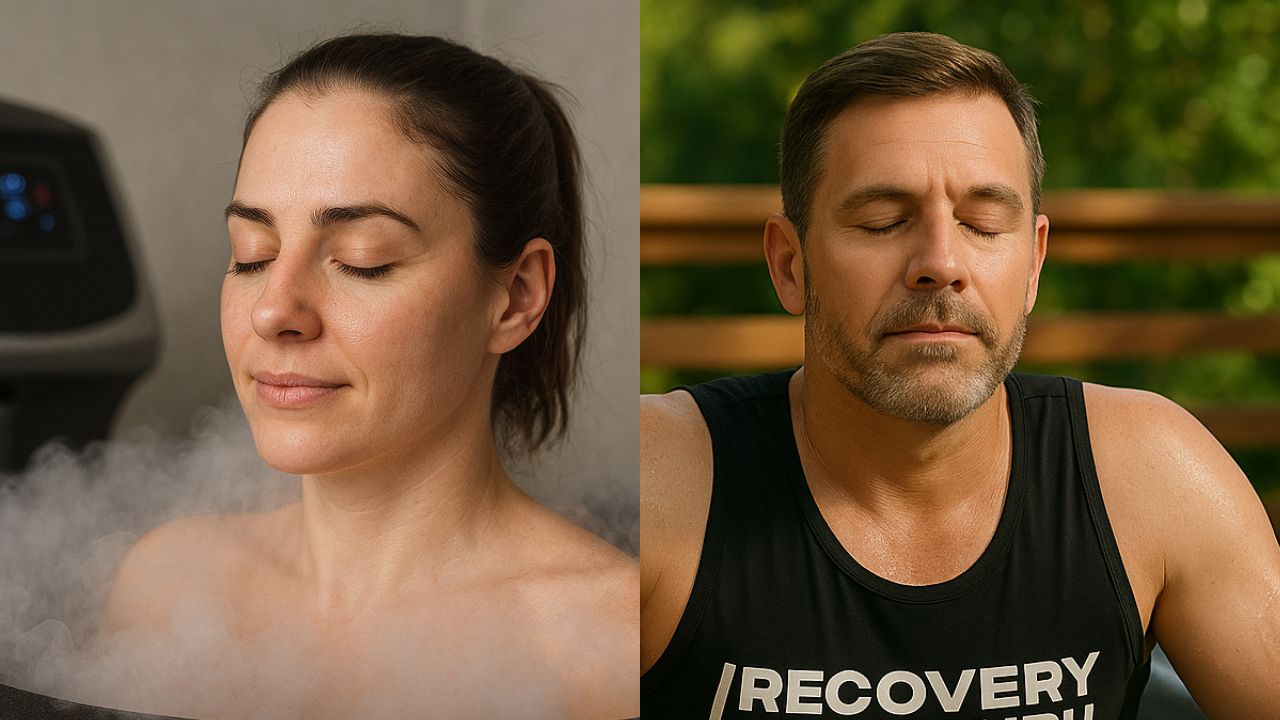This article has been medically reviewed by doctors to ensure it provides accurate, reliable, and up-to-date health information. We only use credible sources to support our content.
Cryotherapy and ice baths are two popular cooling therapies used for muscle recovery and pain relief. Both involve exposing the body to cold temperatures, but they achieve this in very different ways. If you’ve seen athletes stepping into -200°F chambers or plunging into tubs of ice water, you might wonder which method is better or what sets them apart.
This article breaks down the key differences between whole-body cryotherapy and traditional ice baths, explaining how each works and what benefits they offer. By understanding these differences, you can decide which cold therapy (if any) is right for your needs.
What Is Cryotherapy?

Cryotherapy literally means “cold therapy” – it involves exposing the body to extremely low temperatures for a short time. In whole-body cryotherapy, you stand in a special chamber cooled with liquid nitrogen or refrigerated air. Temperatures can range from about -110°C to -140°C (-166°F to -220°F), which is far below freezing. Sessions are very brief, typically 2 to 3 minutes at most. Despite these extreme temperatures, the exposure is so short that it mainly chills the surface of your skin without freezing body tissues. Cryotherapy triggers the body’s fight-or-flight response due to the intense cold.
Blood vessels at the skin’s surface constrict, and blood is shunted to your core to protect vital organs. People often report feeling an adrenaline rush or endorphin release from cryotherapy, leaving them energized and in a good mood afterward. Whole-body cryotherapy was originally developed for medical conditions (like rheumatoid arthritis) and has become a trendy recovery method for athletes to potentially reduce soreness and inflammation.
What Is an Ice Bath?

An ice bath, or cold-water immersion, is a more traditional form of cryotherapy using cold water. Typically, a person immerses their body (up to the neck or at least the legs/waist) in very cold water around 8°C to 15°C (46°F to 59°F). Often ice is added to a tub of water to reach these low temperatures – hence the term “ice bath.” The exposure in water lasts longer than in a cryo chamber, usually 10 to 15 minutes (and sometimes up to 20 minutes depending on tolerance).
The cold water conducts heat away from the body more gradually and deeply. As you sit in an ice bath, your body cools down and blood vessels constrict in the immersed areas. This can help reduce swelling, muscle inflammation, and pain in tissues. Ice baths have been used for decades by athletes after intense exercise – for example, runners or football players might soak in ice water to help their muscles recover. It’s an accessible method because you can do it at home with a tub and some ice, but it does require tolerating the initial shock and discomfort of very cold water on your skin.
You can look at these highly-rated ice baths as examples.
Temperature and Exposure Differences
The most obvious difference between whole-body cryotherapy and ice baths is how cold they are and how long you undergo the treatment. Cryotherapy involves ultra-cold air but for a very short time. Ice baths use “merely” cold water but for a longer duration. In a cryo chamber at -120°C, your skin temperature drops rapidly within minutes. Scientific studies have found that whole-body cryotherapy can lower skin temperature by over 12°C (from baseline) almost immediately, which is a larger skin cooling effect than an ice bath of 8-10°C water might produce in the same time frame.
However, because cryo sessions are so brief, the core body temperature and muscle temperature don’t drop as much as you might expect from the frigid air alone. Ice water, on the other hand, has a high thermal conductivity. Sitting in 10°C water for 10+ minutes will steadily cool your muscle tissue and even slightly lower internal body temperature. In fact, research shows that after about an hour post-treatment, both methods result in similar reductions in muscle temperature and core temperature.
Cryotherapy just achieves a fast, intense surface cooling, whereas ice baths create a deeper cooling effect over several minutes. Practically, this means cryotherapy feels like an intense but brief blast of cold, and you warm up quickly afterward, while an ice bath feels initially very cold but then numbing as you stay in the water longer.
Different Sensations and Comfort
Many users describe whole-body cryotherapy as more tolerable than an ice bath, despite the colder temperature. This may be because the air in a cryo chamber is dry and the exposure time is short – you don’t actually get wet, and once you step out, the extreme cold sensation stops. Your skin never truly “freezes”; it just gets a signal of extreme cold that tricks the body. In contrast, immersing in an ice bath can be physically and mentally challenging for the first couple of minutes.
The wet cold penetrates gradually, and you may feel your muscles stiffening and burning from the chill before they eventually go numb. Some people find this very uncomfortable, especially if they are not used to it. Cryotherapy is often done in minimal clothing (swimsuit or shorts, with protective socks and gloves), and you’re typically standing with your head out of the chamber breathing room air.
You might even have an attendant talking you through the session. In an ice bath, you’re usually fully submerged except your head, sitting alone in cold water, which can feel longer than it actually is! Personal preference plays a big role – those averse to cold water on skin might prefer the “dry” cold of cryo, whereas others don’t mind the wet cold immersion.
Lastly, ice baths can be dangerous if you’re not prepared enough.
Physiological Effects and Recovery Benefits
Both cryotherapy and ice baths aim to aid recovery, reduce pain, and decrease inflammation in the body. The cold causes blood vessels to constrict (vasoconstriction) during exposure, which can help reduce swelling in tissues. Once you exit the cold (stepping out of the chamber or getting out of the tub), your body warms up and blood flow increases again (vasodilation), flushing out metabolic waste from muscles. Pain relief is a well-known benefit of cold therapy – numbing of nerve endings in the skin can reduce the sensation of pain, which is why icing has been used for injuries. Cryotherapy’s extremely cold stimulus might also provoke a strong release of endorphins and adrenaline, which can create a sense of well-being and energy afterward.
Ice baths similarly help with pain and soreness; many athletes report less muscle soreness (DOMS) in the days after hard workouts if they do an ice bath. From a scientific standpoint, studies have shown that cold-water immersion can reduce delayed onset muscle soreness in the 24-72 hours post-exercise compared to no treatment. Whole-body cryotherapy is newer, but early research indicates it can have comparable effects in reducing soreness and inflammation markers.
Some analyses suggest cryotherapy might have an edge in immediately restoring muscle power after exercise (possibly due to that quick adrenaline effect), but overall, both methods are effective for recovery when used properly. It’s worth noting that there is ongoing debate in sports science: while cold therapies can reduce soreness, using them too often might blunt some long-term training adaptations. For the average person or recreational athlete, this is less of a concern, but it’s something elite coaches consider.
Practical Considerations (Cost and Convenience)
One big difference outside of physiology is the practical aspect: access and cost. Taking an ice bath can be as simple as filling a tub with cold water and ice. It’s relatively low-cost (just the price of ice and water) and you can do it at home or at the gym.
Cryotherapy, on the other hand, requires a specialized cryo chamber or cryosauna. These machines are expensive and usually found at wellness centers, physical therapy clinics, or sports facilities. You’ll typically pay per session – costs can range from $30 to $70 or more for a 3-minute cryotherapy session, depending on your location or if you buy a package deal. This means cryo is less accessible for daily use unless you have the budget and a nearby facility.
Ice baths are time-consuming (15 minutes in cold water plus preparation time), and not everyone has a suitable tub or wants to deal with melting ice. But they are generally affordable and you can improvise with a large container or outdoor barrel if you get creative. There are also products like cold plunge tubs and chillers sold nowadays for home use, which regulate water temperature – these can be costly upfront but then allow convenient ice baths without hauling bags of ice.
Safety and Risks
Both cold therapies are considered safe when done correctly, but there are some cautions to keep in mind. With ice baths, the primary risk is staying in too long or in water that is too cold, leading to hypothermia. It’s important to limit immersion time (generally no more than 15 minutes in ~10°C water) and listen to your body – if you start shivering uncontrollably or feel light-headed, it’s time to get out. Extremely cold water can also irritate the skin or even cause ice burns if in direct contact for very long.
Certain medical conditions (like uncontrolled high blood pressure or heart issues) might be contraindications, because the cold immersion can cause sudden changes in blood pressure and heart rate. With whole-body cryotherapy, because exposure is so brief, the risk of core hypothermia is low – however, you must wear protective socks, gloves, and sometimes ear/face coverings to prevent frostbite on extremities. Moisture on the skin (sweat or wet hair) can freeze in the cryo chamber, so users need to be thoroughly dry going in.
There have been rare cases of injury when cryo protocols weren’t followed (for example, unprotected tissue getting frostbite). It’s also crucial to have supervision – most cryo chambers won’t operate without an attendant present. Another safety point: breathing in the extremely cold air can be uncomfortable, so your head is usually outside the chamber or you have an oxygen mask if it’s an enclosed unit.
Neither therapy is recommended if you have certain conditions like Raynaud’s disease (a sensitivity to cold causing circulation issues), or if you are pregnant, very young, or very old and frail. Always start slowly and make sure a healthcare professional is okay with you trying these methods if you have health concerns.
Which One Should You Choose?
Both cryotherapy and ice baths have their pros and cons. If you want a quick, less messy experience and don’t mind paying and traveling to a facility, cryotherapy offers a rapid dose of cold that many find invigorating. It might be a good choice if you’re seeking a whole-body systemic effect and a post-session energy boost. On the other hand, if you prefer a more traditional approach or need to target primarily your legs or lower body, an ice bath is highly effective and easy to do for localized muscle groups (like legs after a run).
Ice baths are also great for overall cooling on a hot day or after a heat-inducing activity like a sauna or intense workout. Budget-wise, ice baths cost little, whereas cryo can get expensive for regular use. In terms of effectiveness, current research suggests both methods help with recovery and soreness in slightly different ways, but neither has been proven drastically superior to the other. It may boil down to how you feel during and after each.
Some athletes alternate or use both: for example, using cryotherapy for a quick pick-me-up during a competition week, versus using ice water therapy after a grueling training session. If possible, you can try each method and see which leaves you feeling better. Always pay attention to your body’s signals. Both cold therapies can be powerful tools for recovery and pain relief when used properly – so the “best” choice is the one that fits your lifestyle, comfort level, and recovery needs.
References
Costello, J. T., Culligan, K., Selfe, J., & Donnelly, A. E. (2012). Muscle, skin and core temperature after -110°C cold air and 8°C water treatment. PLoS ONE, 7(11), e48190. https://doi.org/10.1371/journal.pone.0048190
Abaïdia, A. E., Lamblin, J., Delecroix, B., Leduc, C., McCall, A., Nédélec, M., … & Dupont, G. (2017). Recovery from exercise-induced muscle damage: cold-water immersion versus whole-body cryotherapy. International Journal of Sports Physiology and Performance, 12(3), 402-409. https://doi.org/10.1123/ijspp.2016-0186
Moore, E., Fuller, J. T., Bellenger, C. R., Saunders, S., Halson, S. L., Broatch, J. R., & Buckley, J. D. (2023). Effects of cold-water immersion compared with other recovery modalities on athletic performance following acute strenuous exercise: A systematic review, meta-analysis, and meta-regression. Sports Medicine, 53(3), 687-705. https://doi.org/10.1007/s40279-022-01800-1




